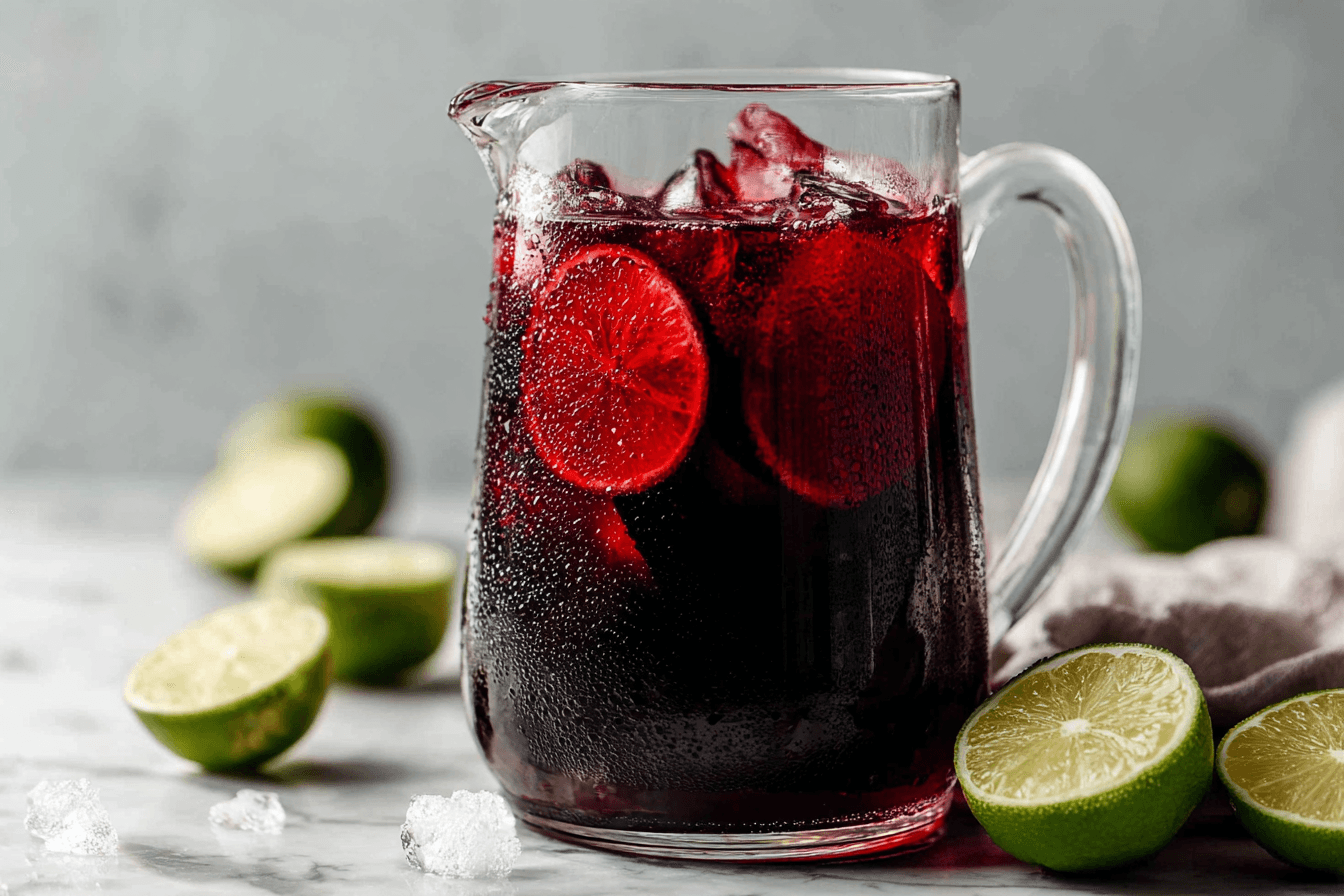Mexican hibiscus tea was the first drink my mamá ever taught me to make. I remember standing barefoot in her small Texas kitchen, sticky from the market, clutching a brown paper bag of dried hibiscus petals she’d scooped from a bulk bin. That bag smelled like sunshine, citrus, and something almost floral—but tart, sharp, and deeply red.
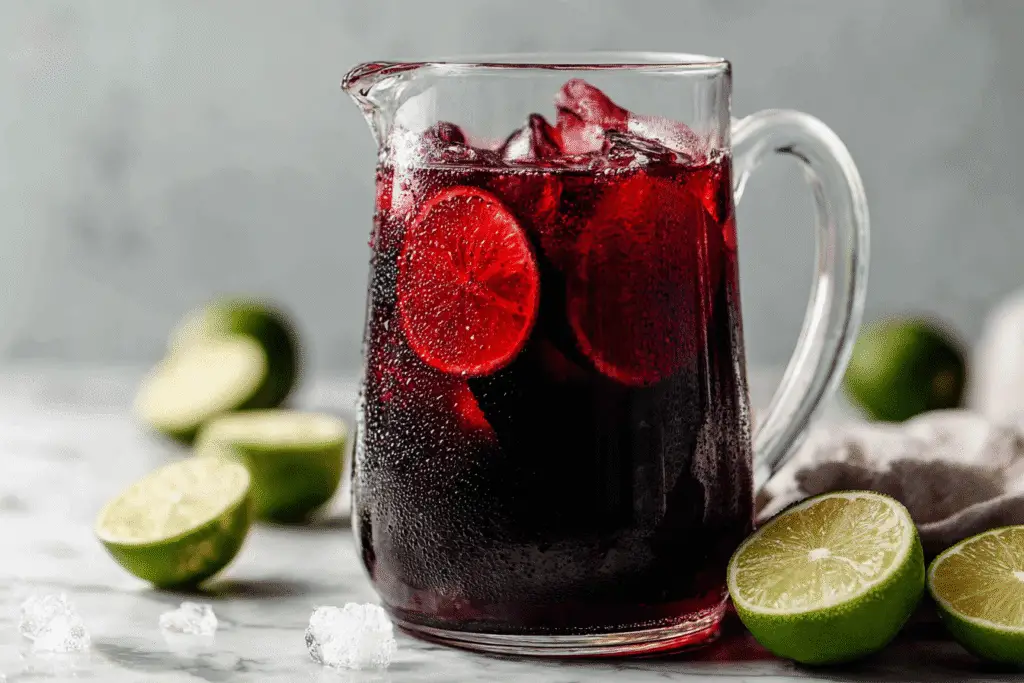
She’d pour boiling water over those petals, and the color would bloom instantly, like magic. Then came the sugar, the clink of ice in big glass pitchers, and the first sip—cool, tangy, and so refreshing it felt like it reached all the way into your bones. In our house, we called it Agua de Jamaica, and it meant summer had officially arrived.
This is the traditional Mexican hibiscus tea I now make for my own kids. It’s not just a drink—it’s a ritual, a way to connect generations and stay cool while doing it.
This is the traditional Mexican hibiscus tea I now make for my own kids—one of many refreshing homemade drinks we keep in rotation all year round.
Let’s dive in.
Quick Take
Mexican hibiscus tea, or Agua de Jamaica, is a tart, vibrant drink made from dried hibiscus petals. Refreshing, healing, and steeped in tradition, it’s easy to make and perfect for hot days or family gatherings. A true staple in Mexican kitchens.
Here's What You'll Find
What Is Mexican Hibiscus Tea?
Mexican hibiscus tea is more than a drink—it’s part of our heritage. Known in Spanish as Agua de Jamaica (pronounced hah-MY-kah), it’s a tangy, ruby-red infusion made from hibiscus flower tea, enjoyed iced across homes, mercados, and street stalls throughout Mexico and Latin America.
In my family, we always kept a gallon jug tucked in the fridge during the hotter months. It was our go-to agua fresca, served in cloudy plastic cups after school or poured over ice in tall glasses for neighbors who dropped by unannounced. If you’ve ever had cranberry juice with a floral twist, you’ve tasted something close—but Agua de Jamaica is unmistakably its own experience.
What is Mexican hibiscus tea called?
In most Mexican households, it’s simply called Agua de Jamaica—which translates directly to “hibiscus water.” Despite the name, it has nothing to do with the Caribbean island of Jamaica. The dried petals come from the hibiscus sabdariffa plant, and we steep them just like tea leaves. That’s why you’ll also hear it called hibiscus flower tea, Jamaica drink, or Mexican hibiscus iced tea.
In Mexican food culture, Agua de Jamaica falls under the agua fresca category—a family of fresh fruit or flower-based beverages that are served chilled and meant to refresh, hydrate, and nourish. You’ll find Jamaica sitting right next to horchata and tamarindo at any good taquería or family cookout.
When I worked in Mexico City’s restaurant kitchens, we’d brew huge vats of this tea before lunch rush. Customers asked for it by name. It wasn’t just something to drink—it was something that made them feel at home.
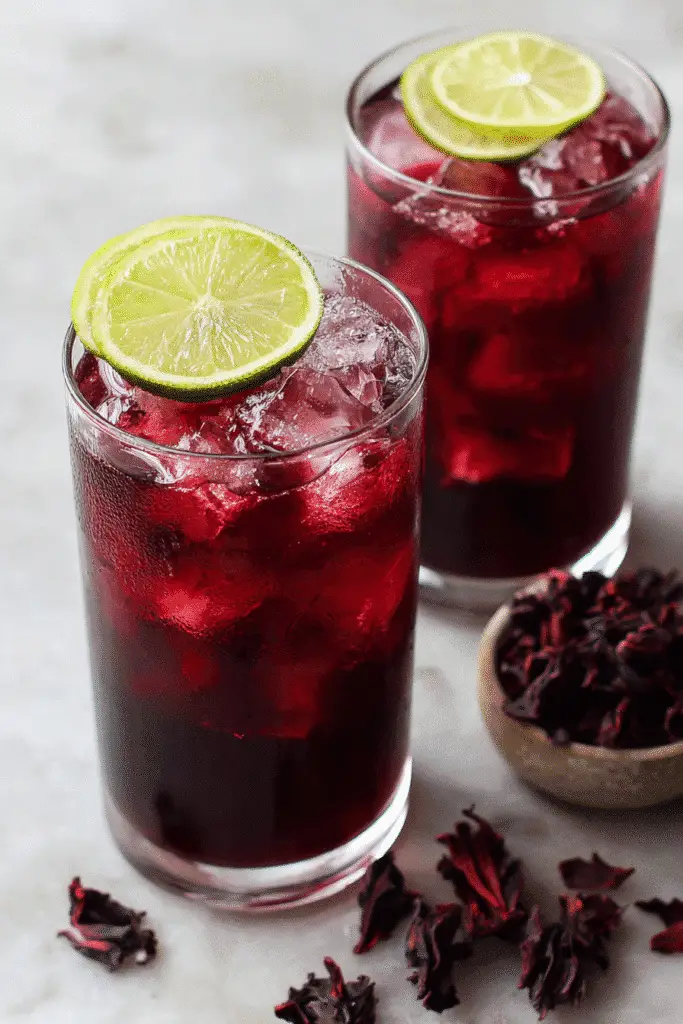
Why do Mexicans drink hibiscus tea?
Because it cools, heals, and connects us—generation after generation.
- Natural remedy
- Traditionally used for digestion, circulation, and reducing inflammation
- Known today as a gentle, caffeine-free anti-inflammatory drink
- Relieves heat
- The tart, bright flavor of tart herbal tea helps cool the body
- A staple in warm climates, especially during summer
- Calming and restorative
- Smooth on the stomach and safe for all ages
- Perfect alternative to sugary or carbonated drinks
- A family ritual
- I make it now for my kids just like my mamá made it for me
- Served cold, lightly sweetened, with a squeeze of lime
- More than refreshment—it’s a way to care
- It brings people together
- After school, after sports, or after long days
- Mexican hibiscus tea is how we gather, heal, and recharge
Some days call for bold herbal flavors like hibiscus, and others for creamy comfort like this hokkaido milk tea recipe—either way, tea has a way of bringing us back to center.
How to Make Mexican Hibiscus Tea Recipe
If there’s one recipe I can make with my eyes closed, it’s Mexican hibiscus tea. Tart, floral, and deeply red, it’s been passed down through generations in my family. This drink isn’t just tradition—it’s refreshment, healing, and home in a glass. Whether I’m making it for a crowd or just a quiet afternoon on the porch, this hibiscus flower tea never lets me down.
In our kitchen, the traditional Mexican hibiscus tea starts with dried hibiscus petals, known as flor de jamaica. Boiled, steeped, and sweetened gently, it’s one of the most essential agua fresca recipes I know. And if you ever get your hands on fresh flowers? Even better.
How to make mexican hibiscus tea recipe from fresh hibiscus flowers
To make Mexican hibiscus tea from fresh hibiscus, begin with 6 to 8 flowers—look for the edible variety, Hibiscus sabdariffa. Carefully separate the red calyx from the seed pod and rinse the petals under cold water. Bring about four cups of filtered water to a boil, then add the petals and remove the pot from heat. Cover and let it steep for 10 to 15 minutes until the water turns a deep reddish-pink. Strain, sweeten to taste, and serve over ice. This version of hibiscus flower tea has a slightly softer, fruitier finish but still carries that bold, tangy kick.
Agua de Jamaica recipe
This is my everyday version of Mexican hibiscus tea, the one I make weekly for my kids. We call it Agua de Jamaica, and it’s the first recipe I learned to make on my own.
Print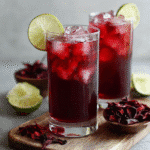
Mexican Hibiscus Tea Recipe (Agua de Jamaica)
- Total Time: 25 minutes
- Yield: 6 servings 1x
Description
This traditional Mexican hibiscus tea (agua de jamaica) is known for its deep red color, tart flavor, and refreshing taste. Enjoy it chilled on hot days or warm in winter.
Ingredients
- 1 cup dried hibiscus petals (flor de jamaica)
- 4 cups boiling water
- 4 cups cold water
- ½–¾ cup sugar (adjust to taste)
- Optional: cinnamon stick, lime juice, thinly sliced ginger
Instructions
- Rinse the dried hibiscus petals thoroughly.
- Bring 4 cups of water to a boil.
- Add hibiscus petals and optional cinnamon or ginger.
- Turn off heat, cover, and steep for 15–20 minutes.
- Strain into a large pitcher.
- Add 4 cups cold water and sugar to taste.
- Chill and serve over ice. Optional: garnish with lime slice or cinnamon stick.
Notes
To make hibiscus tea with fresh flowers, pick 6–8 hibiscus sabdariffa flowers, separate and rinse petals, steep in 4 cups hot water, strain, sweeten, and chill.
How to pick the best fresh hibiscus flowers:
- Look for bright, firm, and vibrant red calyces.
- Avoid wilted or dull-colored petals.
- Harvest in the morning for the freshest blooms.
- Use only edible varieties, like Hibiscus sabdariffa.
- Prep Time: 5 minutes
- Cook Time: 20 minutes
- Category: Drinks
- Method: Boiling
- Cuisine: Mexican
Nutrition
- Serving Size: 1 cup
- Calories: 70
- Sugar: 17g
- Sodium: 5mg
- Fat: 0g
- Saturated Fat: 0g
- Unsaturated Fat: 0g
- Trans Fat: 0g
- Carbohydrates: 18g
- Fiber: 0g
- Protein: 0g
- Cholesterol: 0mg
Keywords: agua de jamaica, hibiscus tea, Mexican drink, flor de jamaica
Ingredients
- 1 cup dried hibiscus petals (flor de jamaica)
- 4 cups boiling water
- 4 cups cold water
- ½ to ¾ cup sugar (adjust to your taste)
- Optional: 1 cinnamon stick, a splash of lime juice, or thin ginger slices
Instructions
Rinse the dried petals in a fine mesh strainer. Bring 4 cups of water to a boil, then add the hibiscus and any optional spices. Turn off the heat and cover the pot. Let it steep for about 15 to 20 minutes until the water turns a vibrant crimson. Strain into a large pitcher and stir in the sugar while the tea is still warm. Add the cold water, refrigerate, and serve over ice. I often garnish it with lime slices or a cinnamon stick, just like my mamá did.
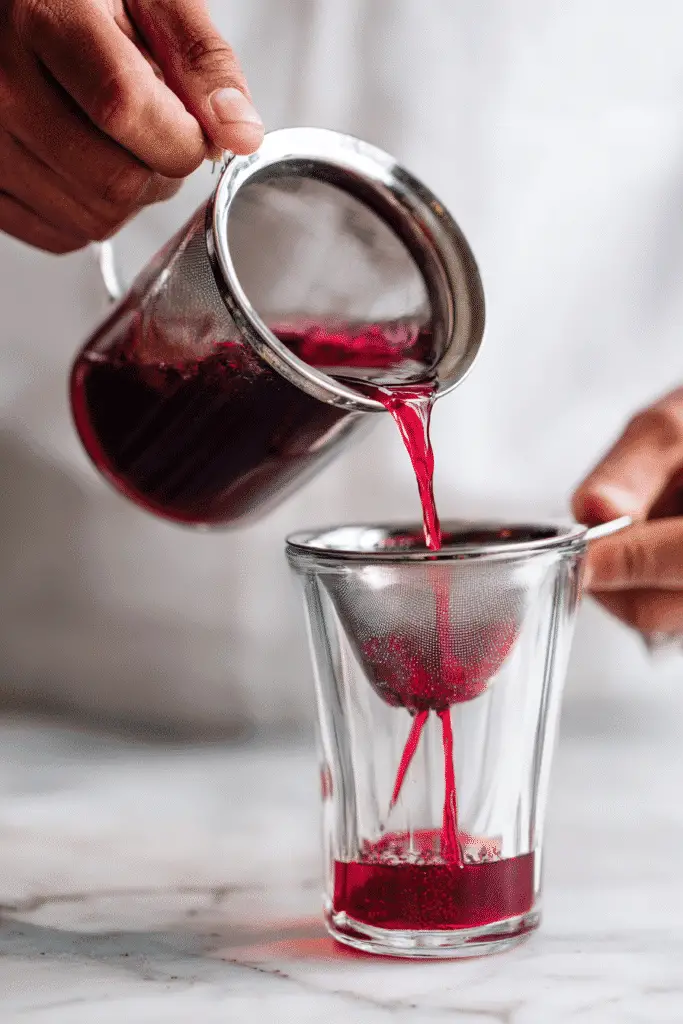
Tools you’ll need
- Medium saucepan
- Fine mesh strainer
- Large pitcher
- Long spoon
- Optional: Mason jars or a vitrolero for serving
Variations
To turn this agua fresca recipe into a party drink, mix equal parts tea and tequila, add a splash of lime and agave, and serve it over crushed ice for a hibiscus margarita. For the kids, I pour the tea into popsicle molds—it freezes beautifully into tart-sweet Jamaica paletas.
No matter how you make it, Mexican hibiscus tea is always vibrant, hydrating, and full of life. It’s not just what we drink—it’s how we remember where we came from.
Hibiscus tea benefits
Growing up, I didn’t know that Mexican hibiscus tea was “healthy.” I just knew it cooled me down after running barefoot through our dusty Texas backyard. But now, as a mom and cook, I understand why my mamá reached for it so often—and why I do the same.
Here are the most common hibiscus tea benefits passed down in our family and supported by science:
- Helps with digestion
A cup of hibiscus flower tea after a heavy meal can ease bloating and support your gut. My grandmother always served it chilled with tamales or enchiladas. - Supports heart health
Hibiscus is known to help lower blood pressure. It’s one of the reasons my tío, who worked in the sun all day, drank a tall glass with lunch. - Boosts hydration naturally
Because it’s caffeine-free and light, Mexican hibiscus tea is a great way to stay hydrated—especially for kids or during hot weather. It’s one of the most naturally refreshing agua fresca recipes you can make. - Packed with antioxidants
Hibiscus is rich in anthocyanins, the same compounds found in berries, which may help reduce inflammation and oxidative stress. No wonder people call it a gentle anti-inflammatory drink. - Can support weight balance
While not a miracle solution, drinking tart herbal tea like hibiscus instead of sugary sodas can support balanced nutrition. I often pack a chilled jar for myself when I go on long bike rides.
But beyond all that, I believe in Mexican hibiscus tea for what it does to the soul. It slows you down. It cools you off. It reminds you that wellness can be simple, beautiful, and made in your own kitchen.
If you’re exploring gentle, natural ways to support your health, don’t miss my bariatric seed trick—a surprising way to stay fuller, longer, with ingredients you already have.
FAQs About Mexican Hibiscus Tea
Is Mexican hibiscus tea good for you?
Yes, it really is. Mexican hibiscus tea is naturally caffeine-free, hydrating, and full of antioxidants. It’s known to help support digestion and heart health. My family has always turned to it as a gentle way to cool the body and settle the stomach. Plus, unlike soda or store-bought juice, you can control the sweetness and ingredients.
What is Mexican hibiscus tea called?
It’s called Agua de Jamaica in Spanish. “Jamaica” refers to the hibiscus flower (specifically Hibiscus sabdariffa), which is steeped in hot water to create this vibrant red tea. Though pronounced “hah-MY-kah,” it has nothing to do with the island—this name is all about the plant and its place in traditional Mexican recipes.
Why do Mexicans drink hibiscus tea?
We drink it for the flavor, the health benefits, and the connection to our roots. In Mexico, it’s common to find hibiscus flower tea served at lunch with tacos, pozole, or even pan dulce. It’s part of our daily rhythm—a cooling drink that brings people together around the table.
What do Mexicans use hibiscus for?
Beyond tea, Mexican cooks use hibiscus in creative ways. The softened petals left over from making Mexican hibiscus tea are often used in vegan tacos, empanadas, or even jam. I sometimes sauté them with onion and garlic for a tangy taco filling—it’s surprisingly good and reduces waste.
Final Thoughts
Every glass of Mexican hibiscus tea I make brings back something I didn’t even realize I missed—my mamá humming in the kitchen, the creak of our screen door swinging open, the way sunlight looked through a red glass.
It’s more than a drink. It’s a pause button. A memory keeper.
Whether you’re sipping it ice-cold on a summer day, freezing it into popsicles for your kids, or adding lime and ginger for a twist, I hope this agua fresca recipe becomes part of your rhythm too.
Let it remind you that even the simplest recipes can carry the deepest stories.
Now it’s your turn:
Did your family make Jamaica growing up? Do you prefer it sweet or tart? Tell me below—I’d love to hear your story.
Join me on Facebook and Pinterest—I’d be thrilled to see what you’re cooking up!
